new tires BUICK REGAL 1995 Owners Manual
[x] Cancel search | Manufacturer: BUICK, Model Year: 1995, Model line: REGAL, Model: BUICK REGAL 1995Pages: 340, PDF Size: 17.16 MB
Page 146 of 340
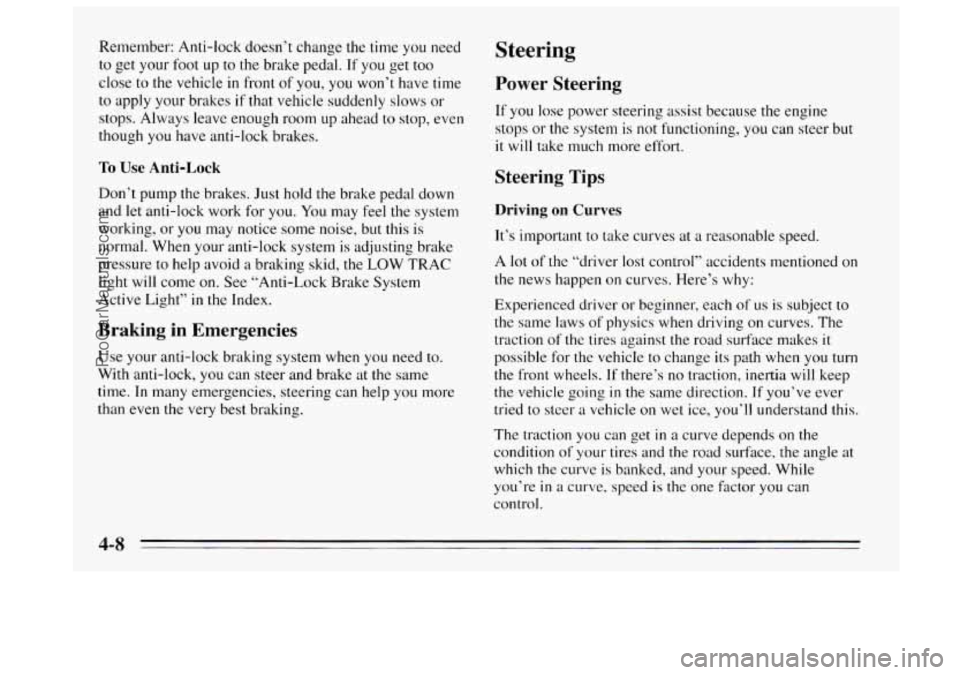
Remember: Anti-lock doesn’t change the time you need
to get your foot up to the brake pedal. If you get too
close to the vehicle in front of you, you won’t have time
to apply your brakes
if that vehicle suddenly slows or
stops. Always leave enough room up ahead
to stop, even
though you have anti-lock brakes.
To Use Anti-Lock
Don’t pump the brakes. Just hold the brake pedal down
and let anti-lock work for you. You may feel the system
working, or
you may notice some noise, but this is
normal. When your anti-lock system is adjusting brake
pressure to help avoid a braking skid, the
LOW TRAC
light will come on. See “Anti-Lock Brake System
Active Light”
in the Index.
Braking in Emergencies
Use your anti-lock braking system when you need to.
With anti-lock,
you can steer and brake at the same
time. In many emergencies, steering can help
you more
than even the very best braking.
Steering
Power Steering
If you lose power steering assist because the engine
stops or the system is not functioning, you can steer but
it will take much more effort.
Steering Tips
Driving on Curves
It’s important to take curves at a reasonable speed.
A lot of the “driver lost control” accidents mentioned on
the news happen on curves. Here’s why:
Experienced driver or beginner, each
of us is subject to
the same laws of physics when driving on curves. The
traction
of the tires against the road surface makes it
possible for the vehicle to change its path when you turn
the front wheels. If there’s no traction, inertia will keep
the vehicle going
in the same direction. If you’ve ever
tried to steer
a vehicle on wet ice, you’ll understand this.
The traction you can get in a curve depends on the
condition
of your tires and the road surface, the angle at
which the curve
is banked, and your speed. While
you’re
in a curve, speed is the one factor you can
control.
ProCarManuals.com
Page 181 of 340

Towing Your Vehicle
Try to have a GM dealer or a professional towing
service tow your Buick. The usual towing equipment is:
A. Sling-type Tow Truck
B. Wheel-lift Tow Truck
C. Car Carrier
If your vehicle has been changed or modified since it
was factory-new by adding aftermarket items like fog
lamps, aero skirting, or special tires and wheels, these
instructions and illustrations may not be correct.
Before you do anything, turn
on the hazard warning
flashers.
When you call, tell the towing service:
0
0
0
0
0
That your vehicle cannot be towed from the front or
rear with sling-type equipment.
That your vehicle has front-wheel drive.
The make, model, and year
of your vehicle.
Whether you can still move the shift lever.
If there was an accident, what was damaged.
When the towing service arrives, let the tow operator
know that this manual contains detailed towing instructions and illustrations. The operator may want
to see them.
5-7
ProCarManuals.com
Page 206 of 340
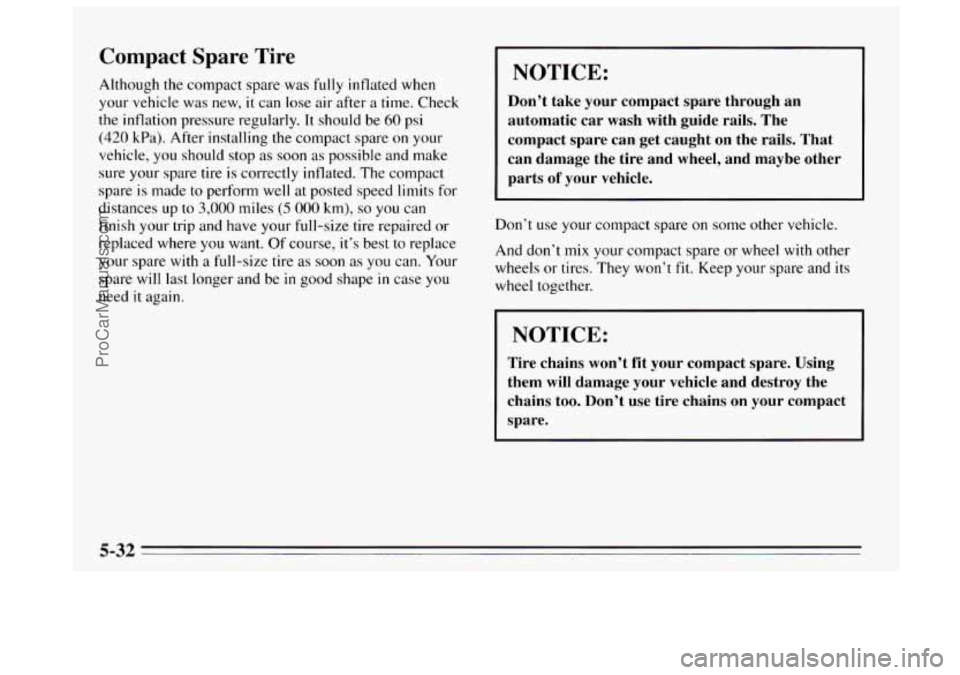
Compact Spare Tire
Although the compact spare was fully inflated when
your vehicle was
new, it can lose air after a time. Check
the inflation pressure regularly. It should be 60 psi
(420 kPa). After installing the compact spare on your
vehicle, you should stop
as soon as possible and make
sure your spare tire
is correctly inflated. The compact
spare is made
to perform well at posted speed limits for
distances
up to 3,000 miles (5 000 km), so you can
finish your trip and have your full-size tire repaired or
replaced where you want.
Of course, it’s best to replace
your spare with
a full-size tire as soon as you can. Your
spare will last longer and be in good shape
in case you
need it again.
1 NOTICE:
Don’t take your compact spare through an
automatic
car wash with guide rails. The
compact spare can get caught on the rails. That
can damage the tire and wheel, and maybe other
parts
of your vehicle.
Don’t use your compact spare on some other vehicle.
And don’t mix your compact spare or wheel
with other
wheels or tires. They won’t
fit. Keep your spare and its
wheel together.
NOTICE:
Tire chains won’t fit your compact spare. Using
them will damage your vehicle and destroy the
chains too. Don’t use tire chains on your compact
spare.
5-32
ProCarManuals.com
Page 238 of 340

Tires
We don’t make tires. Your new vehicle comes with
high-quality tires made by a leading tire manufacturer.
These tires are warranted by the tire manufacturers and
their warranties are delivered with every new Buick.
If
your spare tire is a different brand than your road tires,
you will have a tire warranty folder from each
of these
manufacturers.
ProCarManuals.com
Page 240 of 340
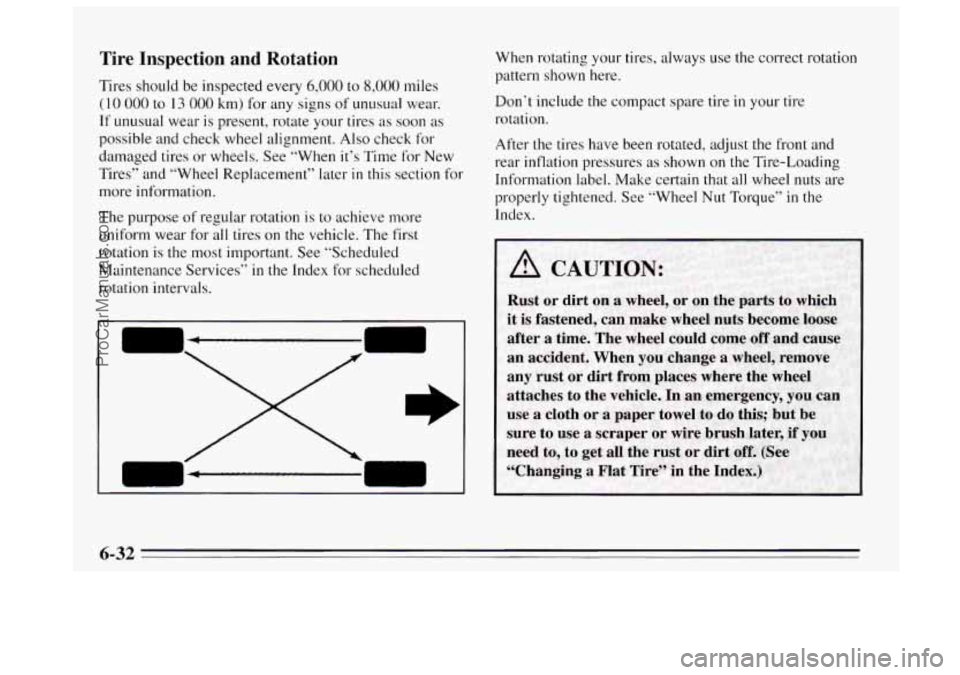
Tire Inspection and Rotation
Tires should be inspected every 6,000 to 8,000 miles
(I 0 000 to 13 000 km) for any signs of unusual wear.
If unusual wear is present, rotate your tires as soon as
possible and check wheel alignment. Also check for
damaged tires or wheels. See “When
it’s Time ,for New
Tires” and “Wheel Replacement” later
in this section for
more information.
The purpose of regular rotation is to achieve more
uniform wear for all tires on the vehicle. The first
rotation is the most important. See “Scheduled
Maintenance Services”
in the Index for scheduled
rotation intervals. When
rotating your tires, always use the correct rotation
pattern shown here.
Don’t include the compact spare tire
in your tire
rotation.
After the tires have been rotated, adjust the front and
rear inflation pressures
as shown on the Tire-Loading
Information label. Make certain that all wheel nuts are
properly tightened. See “Wheel
Nut Torque” in the
Index.
6-32
ProCarManuals.com
Page 241 of 340
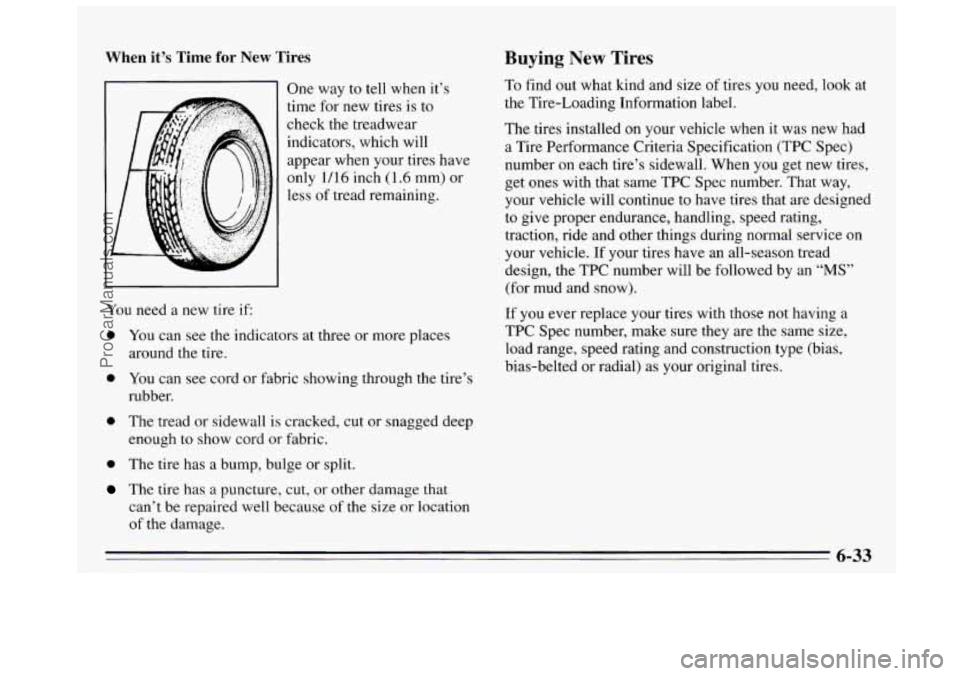
When it’s Time for New Tires
One way to tell when it’s
time for new tires is to
check the treadwear
indicators, which will
appear when your tires have
only 1/16 inch (1.6 mm) or
less
of tread remaining.
You need a new tire if:
0 You can see the indicators at three or more places
around the tire.
0 You can see cord or fabric showing through the tire’s
rubber.
0 The tread or sidewall is cracked, cut or snagged deep
enough
to show cord or fabric.
0 The tire has a bump, bulge or split.
The tire has a puncture, cut, or other damage that
can’t be repaired well because of the size or location
of the damage.
Buying New Tires
To find out what kind and size of tires you need, look at
the Tire-Loading Information label.
The tires installed on your vehicle when it was new had
a Tire Performance Criteria Specification (TPC Spec)
number on each tire’s sidewall. When you get new tires,
get
ones with that same TPC Spec number. That way,
your vehicle will continue to have tires that are designed
to give proper endurance, handling, speed rating,
traction, ride and other things during normal service on
your vehicle. If your tires have an all-season tread
design, the TPC number will be followed by an
“MS”
(for mud and snow).
If you ever replace your tires with those not having a
TPC Spec number, make sure they are the same size,
load range, speed rating and construction type (bias,
bias-belted or radial) as your original tires.
6-33
ProCarManuals.com
Page 251 of 340
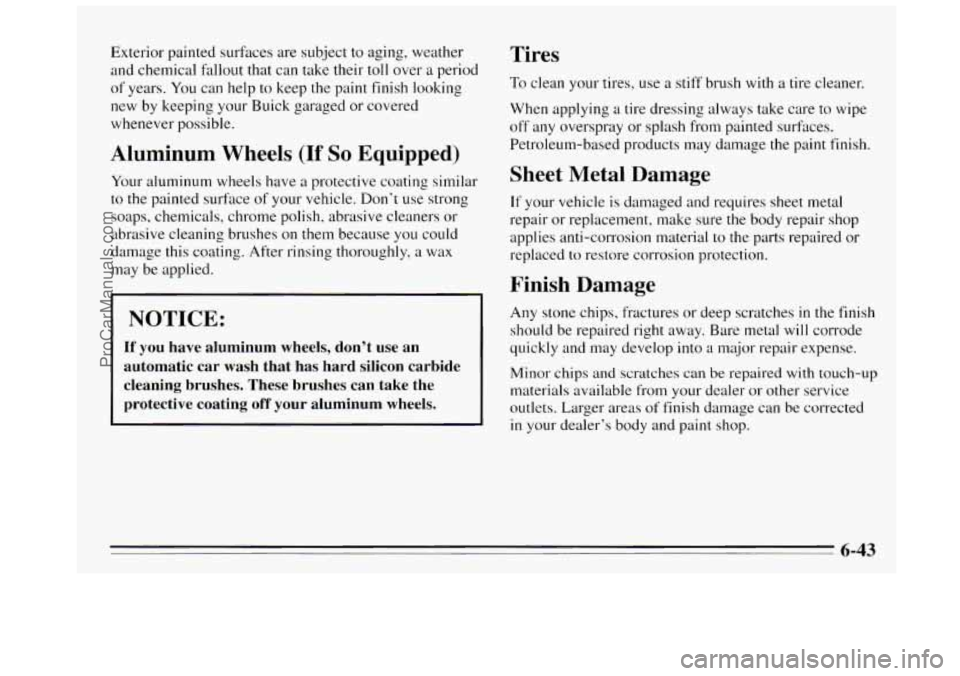
Exterior painted surfaces are subject to aging, weather
and chemical fallout that can take their toll over a period
of years.
You can help to keep the paint finish looking
new by keeping your Buick garaged or covered
whenever possible.
Aluminum Wheels (If So Equipped)
Your aluminum wheels have a protective coating similar
to
the painted surface of your vehicle. Don’t use strong
soaps, chemicals, chrome polish, abrasive cleaners or
abrasive cleaning brushes on them because you could
damage this coating. After rinsing thoroughly,
a wax
may be applied.
NOTICE:
If you have aluminum wheels, don’t use an
automatic car wash that has hard silicon carbide
cleaning brushes. These brushes can take the
protective coating
off your aluminum wheels.
Tires
To clean your tires, use a stiff brush with a tire cleaner.
When applying
a tire dressing always take care to wipe
off any overspray or splash from painted surfaces.
Petroleum-based products may damage the paint finish.
Sheet Metal Damage
If your vehicle is damaged and requires sheet metal
repair or replacement, make sure the body repair shop
applies anti-corrosion material to the parts repaired or
replaced
to restore corrosion protection.
Finish Damage
Any stone chips, fractures or deep scratches in the finish
should be repaired right away. Bare metal
will corrode
quickly and may develop into
a major repair expense.
Minor chips and scratches can be repaired with touch-up
materials available from your dealer or other service
outlets. Larger areas of finish damage can be corrected
in your dealer’s body and paint shop.
6-43
ProCarManuals.com
Page 337 of 340
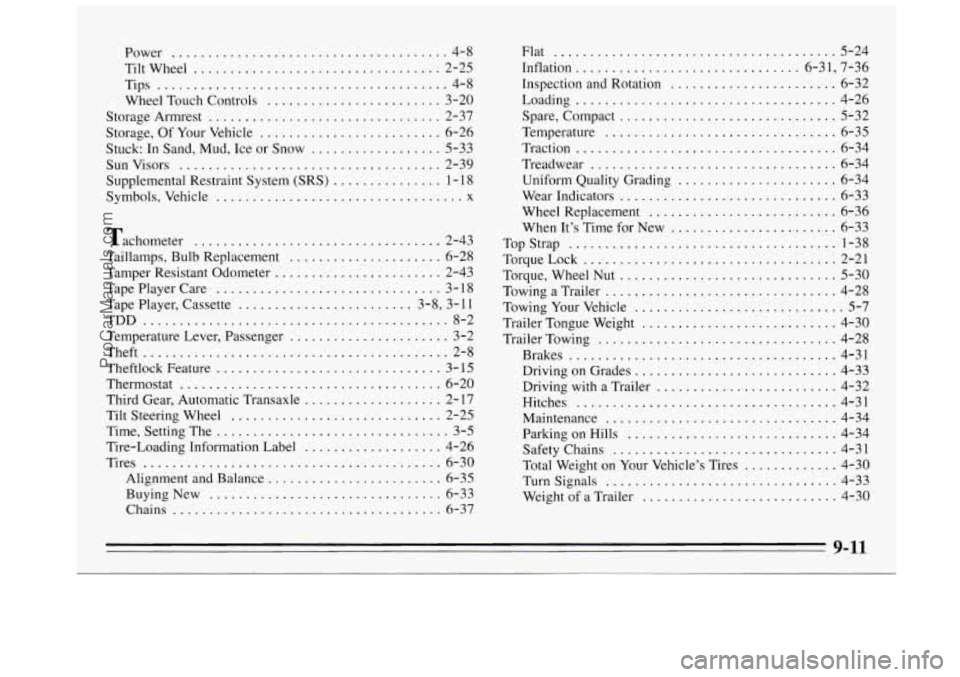
i
Power ...................................... 4-8
Tiltwheel
.................................. 2-25
Tips
........................................ 4-8
Wheel Touch Controls
........................ 3-20
Storage Armrest
................................ 2-37
Storage. Of Your Vehicle
......................... 6-26
Stuck: In Sand. Mud. Ice or Snow
.................. 5-33
Sunvisors
.................................... 2-39
Supplemental Restraint System (SRS)
............... 1 - 18
Symbols. Vehicle
.................................. x
Tachometer .................................. 2-43
Taillamps. Bulb Replacement
..................... 6-28
Tamper Resistant Odometer
....................... 2-43
Tape Player Care
............................... 3-18
Tape Player. Cassette
........................ 3.8. 3.11
Temperature Lever. Passenger
...................... 3-2
Theft
.......................................... 2-8
Theftlock Feature
............................... 3- 15
Thermostat .................................... 6-20
Third Gear. Automatic Transaxle
................... 2- 17
Tilt Steering Wheel
............................. 2-25
Time. Setting The
................................ 3-5
Tire-Loading Information Label
................... 4-26
Tires
......................................... 6-30
Alignment and Balance
........................ 6-35
BuyingNew
................................ 6-33
Chains
..................................... 6-37
TDD
.......................................... 8-2 Flat
....................................... 5-24
Inflation
............................... 6.31. 7.36
Inspection and Rotation
....................... 6-32
Loading
.................................... 4-26
Spare. Compact
.............................. 5-32
Temperature
................................ 6-35
Traction
.................................... 6-34
Treadwear
.................................. 6-34
Uniform Quality Grading
...................... 6-34
Wear Indicators
.............................. 6-33
Wheel Replacement
.......................... 6-36
When It’s Time for New
....................... 6-33
TorqueLock
................................... 2-21
Torque. Wheel Nut
.............................. 5-30
Towing a Trailer
................................ 4-28
Towing Your Vehicle
............................. 5-7
Trailer Tongue Weight
........................... 4-30
Trailer Towing
................................. 4-28
Brakes
..................................... 4-31
Driving on Grades
............................ 4-33
Driving with a Trailer
......................... 4-32
Hitches
.................................... 4-31
Maintenance
................................ 4-34
Parking on Hills
............................. 4-34
Safety Chains
............................... 4-31
Turnsignals
................................ 4-33
Weight of a Trailer
........................... 4-30
TopStrap
..................................... 1-38
Total Weight
on Your Vehicle’s Tires ............. 4-30
9-11
ProCarManuals.com